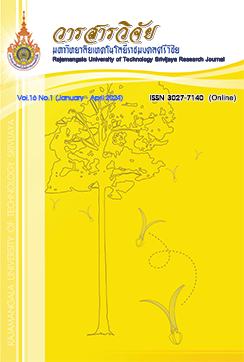Effects of Sungyod Rice Flour and Maltodextrin on Quality of Cookies
Keywords:
Sungyod rice flour, maltodextrin, cookies, wheat flour, healthy foodAbstract
The purpose of this study was to determine the effects of wheat flour substitution with Sungyod rice flour (0, 40, 60, and 80 by weight) and maltodextrin (0, 30, 50, and 70 by weight) on physical qualities (color value and texture testing), chemical qualities (humidity and fat) and sensory testing of cookies. It was found that the increasing amount of Sangyod rice flour resulted in a decrease of L* and b* values, but an increase of a* value and hardness of cookies. The sensory values in terms of color, flavor, taste, crispness, and overall liking had significantly improved (p£0.05). Consumers showed the highest preference score at 60% of rice starch. Increasing maltodextrin content in cookie product did not significantly affect the color values (L*, a* and b*) and the moisture values (p>0.05). The hardness value will increase significantly (p£0.05). The substitution of Maltodextrin at 30% in cookies received favorable score in taste and the highest overall preferences (8.18).
References
AOAC. 2019. Official Methods of Analysis, The Association of Official Analytical Chemists. 21st ed. Gaithersburd, MD, USA.
AOAC. 2000. Official Methods of Analysis, The Association of Official Analytical Chemists. 17thed. Gaithersburd, MD, USA.
Banchuen, J., Thammarutwasik, P., Ooraikul, B., Wuttijumnong, P. and Sirivongpaisal, P. 2010. Increasing the bioactive compounds contents by optimizing the germination conditions of Southern Thai Brown Rice. Songklanakarin Journal Science and Technology 32: 207-326.
Chooklin, S. 2013. Ultrasound-Assisted Extraction of Phenolic Compounds from Brown Rice and Their Antioxidant Activities. Kasetsart Journal (Natural Science) 47: 864-873.
Crehan, C.M., Hughes, E., Troy, D.J. and Buckley, D.J. 2000. Effects of Fat Level and Maltodextrin on the Functional Properties of Frankfurters Formulated with 5, 12 and 30% Fat. Meat Science 55(4): 463-469.
Division of rice research and development. 2009. Use of Sung Yod Phatthalung rice. Rice department Ministry of Agriculture and Cooperatives. Available Source: https: //WWW.ricethailand.go.th, August, 26, 2021. (in Thai)
Gandia, H.F., Jimenez, A.M., Cabanes, J., Garcia, C.F. and Escribano, J. 2010. Stabilization of the Bioactive Pigment of Opuntia Fruits through Maltodextrin Encapsulation. Journal of Agricultural and Food Chemistry 58(19): 10646-10652.
Judith, W.R. 2002. Fat Substitutes and Health. Circulation 105: 2800-2804.
Kumaran, B.D. and Maheshwari, K.S. 2022. Development of Cookies Prepared from Red Rice Flour (Oryza sativa), Papaya Fruit, Brown Sugar and Proximate Analysis. International Journal of Food and Nutritional Sciences 11(4): 61-66.
Lekjing, S., Noonim, P., Boottajean, S. and Chantawong, P. 2019. Effect of Substitution of Wheat Flour with Sangyod Brown Rice Flour on Physicochemical and Sensory Qualities in Snack Product. Khon Kaen Agriculture Journal 47: 679-684. (in Thai)
Miyazato, S., Nakagawa, C., Kishimoto, Y., Tagami, H. and Hara, H. 2010. Promotive Effects of Resistant Maltodextrin on Apparent Absorption of Calcium, Magnesium, Iron and Zinc in Rats. European Journal of Nutrition 49(3): 165-171.
Nooniam, T. and Wongsudalak, W. 2016. Research Report on Utilization of Sang-Yod rice flour in Thai shortbread cookies. Songkhla Rajabhat University. (in Thai)
Psimouli, V. and Oreopoulou, V. 2013. The Effect of Fat Replacers on Batter and Cake Properties. Journal of Food Science 78(10): 1495-1502.
Rodmui, A. and Jitwaropas, O. 2007. Production of Cookies using Flour Partial Substituted with Hom Nil Rice Flour. Journal of Food Technology, Siam University 3(1): 37-43. (in Thai)
Seaman, C.E.A., Woods, M. and MacKenzie, D. 1996. Fat Content and Sponge Cake Quality. British Food Journal 98(1): 20-22.
Shukla, U., Sehar, M., Tongbram, T., Yaseen, M. and Bora, J. 2020. Physical and Sensory Characteristics of Cookies from Rice and Amaranth Flour Blends. European Food Science and Engineering 1(1): 24-29.
Sinchaipanit, P., Hemwadee, P., Disni,l S. and Twichatwitayakul, R. 2017. Effect of Maltodextrin on Quality Attributes of Reduced Fat Brownies. Journal of Food Health and Bioenvironmental Science 10(3): 1-16.
Somboonpanyakul, P., Hudthagosol, C., Meekhruerod, A., Lasukhang, W. and Chuaduangpuy, D. 2012. Development of Sinlek Brown Rice Cookie. Agricultural Science Journal 43(2): 565-568. (in Thai)
Sompong, R., Siebenhandl-Ehn, S., LinsgergerMartin, G. and Berghofer, E. 2011. Physicochemical and antioxidative properties of red and black rice varieties from Thailand, China and Sri Lanka. Food Chemistry 124: 132-140.
Syed, H.M., Jadhav, B.A. and Salve, R.V. 2011. Studies on Preparation of Low Calorie Cake using Pearl Millet (Bajra) Maltodextrin. Journal of Food Processing Technology 2(5): 1-3.
Wangpankhajorn, P., Maneechot, S., Junsi, M., Jannu, T. and Samakradhamrongthai, S.R. 2020. Effect of substitution of wheat flour with Sungyod rice flour on physical and sensory qualities in cookies. Journal of Science and Technology 9(2): 63-70. (in Thai)
Yeomans, M.R., Gray, R.W. and Conyers, T.H.B. 1998. Maltodextrin Preloads Reduce Food Intake without Altering the Appetiser Effect. Physiology Behavior 64(4): 501-506.
Downloads
Published
How to Cite
Issue
Section
License
Copyright (c) 2024 Rajamangala University of Technology Srivijaya Research Journal

This work is licensed under a Creative Commons Attribution-NonCommercial-NoDerivatives 4.0 International License.
The content and information in the article published in Journal of Rajamangala University of Technology Srivijaya It is the opinion and responsibility of the author of the article. The editorial journals do not need to agree. Or share any responsibility.







